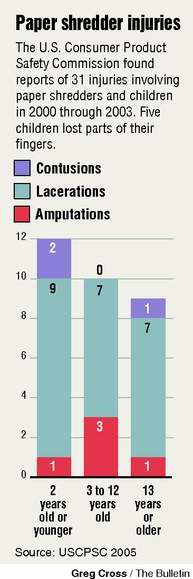Household shredders pose danger to children’s fingers
Published 4:00 am Thursday, February 16, 2006

- Household shredders pose danger to children's fingers
As more American households add paper shredders to protect themselves against identity theft, public health authorities warn the number of children injured by the devices is on the increase.
From January 2000 through September 2004, the United States Consumer Products Safety Commission received 50 reports of finger injuries involving paper shredders. The majority of these reports involved children under the age of 5.
From 2000 to 2003, 71 percent of the injuries involved children under the age of 12, and 54 percent children under the age of 3. Five of the injured children had to have parts of their fingers amputated.
Those numbers led the safety commission to conduct an investigation of shredder safety and to issue a paper shredder alert warning parents in particular about the risk to young children.
An article published in this month’s issue of the journal Pediatrics reviewed the results of the investigation and presented a case study of a toddler injured by a paper shredder.
”It’s a dangerous piece of machinery and leaving it in the home unattended and accessible to young children could result in serious hand injury,” said author Dr. George Foltin, director of the pediatric emergency medicine department at Bellevue Hospital Center in New York. ”If you have one, it needs to be unplugged and out of children’s reach.”
The authors summarized the case of a 2-year-old girl who came to the emergency room with two injured fingers. The child placed her hand on top of the shredder while papers were being shredded and her fingers were drawn into the opening. Her father immediately unplugged the shredder, broke open the plastic top and, with a great deal of effort, pried apart the shredder blades to release the girl’s fingers.
The doctors found the girl’s fingers had been crushed and broken. They deferred a decision on amputation but expected that her fingertips will never return to normal functioning or appearance.
The authors recommended redesigning the shredder opening to reduce the risk of fingers coming into contact with the blades.
They suggested parents keep the machines in places above the reach of toddlers, keep them unplugged when not in use, and never allow children to operate shredders even under direct supervision.
According to the article, $350 million in paper shredders are sold each year in the United States. Sales have increased 35 percent over the past five years, mainly driven by the consumer sales.
Yet manufacturers adhere only to voluntary safety standards. Many rely on standards created by Underwriters Laboratories, an independent, not-for-profit organization that evaluates products in the interest of public safety. Products that meet the guideline are marked with the UL symbol.
The UL standard relies on testing using a semi-compressible probe made to represent a finger. The safety commission said the size of the artificial finger represents a worst-case scenario for a 12-year-old child and does not adequately test the risk for younger children. The commission found the heights of most models ranged from 13 inches to 16.5 inches, allowing easy access to the paper opening for the average toddler. The distance from the opening to the cutting blades ranged from 0.08 to 1.29 inches. The average length of a 13- to 18-month-old child’s finger is 1.77 inches.
Commission officials are now working with Underwriters Laboratories to improve the voluntary shredder safety standards to better address the danger of children’s fingers being drawn into the devices. The company also issued a warning to consumers in 2004 about shredder safety.
”Even though more people are using paper shredders as part of their home offices for telecommuting and protection against identity theft, parents still need to remember that safety should be their first concern,” says John Drengenberg, manager of consumer affairs at Underwriters Laboratories. ”If children are left alone around a paper shredder, they may think it is a toy, rather than a piece of office equipment.”
But even under the supervision of an adult, shredders can be dangerous for kids. The safety commission documented the case of a mother trying to teach her children how to use the shredder safely. When her 6-year-old daughter was distracted by a younger sibling and the mother had turned her head for a moment, the girl’s fingers were drawn into the shredder. She lost three fingertips. The commission said children lack the coordination to release the paper in time to avoid catching their fingers in the machine.
The commission’s investigators also found that many models do not come with an off switch. Many include only forward, reverse or auto settings. That means that once something is inserted into the shredder, activating the blades, they can go forward or backward but will not stop until the object clears the blades. Only unplugging the machine will stop the blades with something stuck inside.
Additionally, most shredders have no way to release the blades. Investigators say many injured children arrive at the emergency room with the shredder still attached to their fingers. Even emergency room personnel have had trouble removing the device. One hospital reported having to use the building maintenance personnel’s tools to disassemble the machine.
The commission concluded that shredders pose the biggest injury risk to children between the ages of 15 and 30 months, because they lack risk awareness and physical coordination, yet have easy access to and natural curiosity about shredders.






